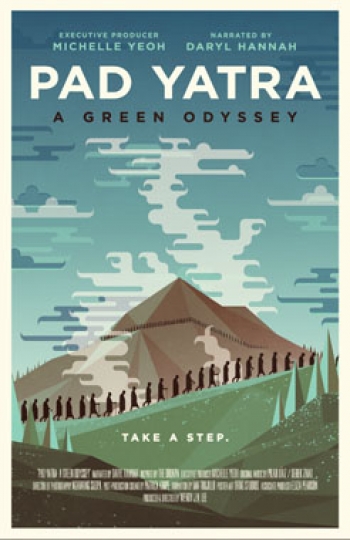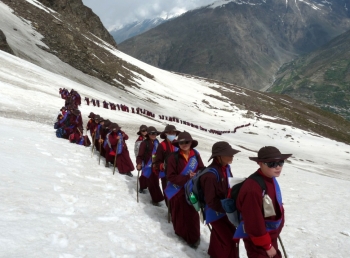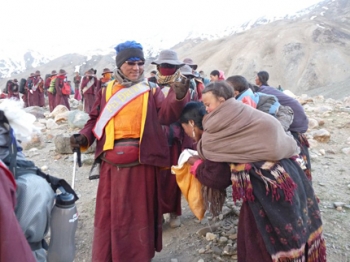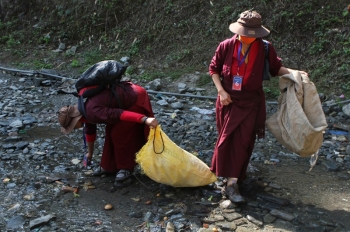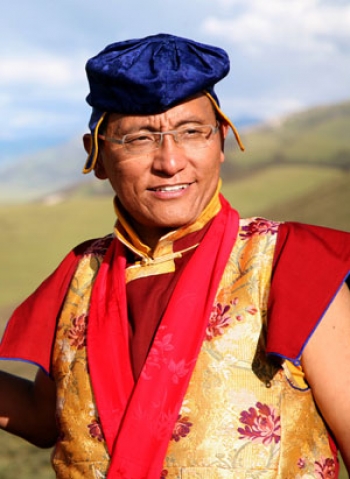Some of us are close friends with the natural world. We spend our weekends in the mountains; we own Gore-Tex and lots of wicking socks. Sometimes, we’re more like nature’s acquaintances: we drive hybrid cars and recycle our batteries, but we don’t spend too much spare time with that mossy old geezer, Mother Nature. And plenty of us never give her a second thought.
The peoples of the Himalaya have a much closer relationship with their environment. Living at high altitude, they’re exposed to nature’s fluctuations. As such, they have encountered environmental change in an immediate way.
In 2010, a cloud dropped 250 mm of rain on the north Indian region of Ladakh in an hour. Mud swept through the area, destroying homes, engulfing a school. The Himalayas have always been a place of extremity, but this sudden weather was new. Because of deforestation, the storm had an outsized effect.
At this point, we almost universally acknowledge the severity of our century’s environmental crisis. However, we still lack a comprehensive strategy for solving the problem. Each of us does what we can: we take small steps in many directions, hoping they add up to larger change.
His Holiness the 12th Gyalwang Drukpa traveled to Hemis monastery in Ladakh and surveyed the landslide damage in 2010. The region couldn’t afford to ignore its environmental problems. Glacial melt, which feeds Asia’s great rivers, was full of plastic waste. Locals were getting sick from drinking the water. Deforestation had made landslides and flooding more common. Centuries-old frescoes in the monastery were eroding. And of course, there were these new extreme weather events: signs of a changing climate.
His Holiness called for a Padyatra: a foot pilgrimage across the mountains, to educate Himalayan residents on environmental practices. “Pad Yatra: A Green Odyssey” is a film that documents this 450-mile trek, led by His Holiness that included 700 nuns and laypeople. Along the way, they encountered injury and hunger, snowstorms, altitude sickness, and moments of pure joy. The film is on tour and recently screened in Hong Kong, where His Holiness spoke about environmental engagement.
“For people in the Himalaya, environmental preservation is self-preservation,” His Holiness said. Environmental degradation extends to the cultural lives of the people, whose heritage is linked with the landscape. Loss of stability in the natural world entails a loss of culture. The trekkers taught villagers about reducing their use of plastic and planting trees, and they collected trash along the route. But the larger message was one of global engagement.
“They have to feel that they are somebody. . . and they can contribute to the world,” His Holiness told the Hong Kong crowd. As one of the most important Buddhist leaders in the Himalayan region, His Holiness has a built-in network through which he can educate and engage. He has made great strides—pun intended—toward making the region healthier and safer.
But environmental problems don’t always divide evenly. Global warming is aptly named: it stretches across national boundaries, across conflict zones, across oceans. It envelops us all. China’s smog becomes pollution in California, and American plastics have made new islands, adrift in the Pacific. If we ever needed proof of our interconnectedness, this crisis is it. With a globalized problem, the poor and isolated often suffer the most. They face the daily dangers of an unhealthy planet, while those of us who are prime culprits of climate change remain happily unengaged.
This film encourages engagement via “friendliness,” a word that His Holiness returned to over and over during the talk. “Nature gives us life; it gives us support,” he said. “We live on nature. Therefore we have to pay a visit to nature and build a relationship with [it].”
For people in remote villages, friendliness with nature may not be too difficult to achieve. The film’s cinematography reveals a harsh, gorgeous landscape, treacherously high, often inclement. The land is a character: it pouts and rages, and it needs to be cared for.
Those of us in cities or suburbs throughout the world rarely get friendly with nature. Our lives are lived on tablet screens, in air conditioning, away from the melodies of birdsong and changes of seasons. Yet the environment still finds ways to affect us. As I write this, it is a particularly fine day here in Hong Kong. An old woman is squinting in the sun as she gently parts it with her hands, moving through tai chi sequences. Students are sprawled on benches with open books. The threat of spring has brought us outside, hoping to catch a glimpse of that long-lost friend: the natural world.
Even if we’ve been antisocial with nature, the Padyatra—that of community bonded together on a common journey—still applies to those of us in cities. Can we begin to understand the connection between our own actions and the catastrophic results in the distant Himalaya? How can we take responsibility alongside the people of that region? How can we set out on our own journey, toward a healthier planet, toward a more engaged global community?
His Holiness says: “it begins with a step”. A Padyatra needn’t be an epic trek. It can be a walk to a local park at sunrise; a weekend hike with friends; schlepping the extra half-block to find a recycling bin. It can be riding a bicycle in the sunshine instead of taking a car. It means getting out of the chair and choosing to walk forward, in the company of others, for change.
“Pad Yatra: A Green Odyssey” had won awards and is screening worldwide at festivals. Helped by its celebrity producer, Hong Kong actress Michelle Yeoh, the documentary is getting good press. But the film and the Padyatra itself don’t provide an ultimate solution. “I’m hoping we can set an example to the rest of the world,” His Holiness said. His hope was that journey might educate and awaken people—both the locals in the mountains, and those who watch the film worldwide—to green living.
Padyatra is a commitment. As the film showed, it’s no easy journey. It takes toughness, bravery, endurance, and a “fierce compassion” for all life. The people of the Himalaya face a region that will likely change drastically in the next fifty years. Scientists aren’t sure if climate change will reduce the glaciers to rocky fields, or if a fluctuating climate might keep the region socked with unseasonal storms. By “being friendly” toward nature, we re-engage in a relationship with the people of those remote communities, and acknowledge our responsibility to walk together toward a more just world.
PAD YATRA: A Green Odyssey [Trailer] from Wendy J.N. Lee on Vimeo.
